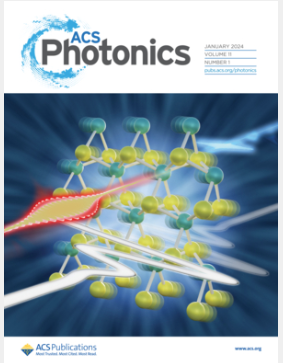用聚合物衍射光栅控制锡钙钛矿的受激发射
IF 6.5
1区 物理与天体物理
Q1 MATERIALS SCIENCE, MULTIDISCIPLINARY
引用次数: 0
摘要
FASnI3 (FA: formamidinium)多晶钙钛矿薄膜已被证明是一种极好的增益介质和毒性较低的含铅钙钛矿发光材料的替代品。然而,锡钙钛矿的不稳定性阻碍了沉积后薄膜的后处理,使其在二维光学结构中的集成具有挑战性。在本文中,FASnI3多晶薄膜在低成本和工业兼容的技术下成功地与聚合物衍射光栅集成。光栅是在全息技术下制造的,允许在大面积(≈1 cm2)上进行图像化和钙钛矿薄膜或包层的后沉积。结果表明,光栅周期是控制放大自发发射特性的一个合适的调谐参数。值得注意的是,模式与发射带的重叠代表了一种合适的机制,可以选择性地增强ASE(调谐器件)的产生,达到100 μJ/cm2以上的中等阈值,并提取在薄膜(调谐器件)颗粒上产生的随机激光线。这些结果代表了锡钙钛矿基光源的重大进展,为下一代光子应用提供了经济高效的技术。本文章由计算机程序翻译,如有差异,请以英文原文为准。

Control of Stimulated Emission of Tin Perovskites through Polymeric Diffractive Gratings
FASnI3 (FA: formamidinium) polycrystalline perovskite thin films have demonstrated to be an excellent gain media and less toxic alternative to the Pb-containing perovskite light emitters. However, the instability of Sn perovskites prevents the postprocessing of the film after deposition, making its integration in two-dimensional optical architectures challenging. In this article, FASnI3 polycrystalline thin films are successfully integrated with polymeric diffractive gratings under cost-effective and industrial compatible technology. The gratings are fabricated under holographic techniques, allowing patterning on large areas (≈1 cm2) and the posterior deposition of the perovskite films or cladding layers. The grating period demonstrated to be an adequate tuning parameter to control the amplified spontaneous emission (ASE) properties. Notably, the overlap of the mode with the emission band represents a suitable mechanism to selectively enhance the generation of the ASE (tuned device) above a moderate threshold of 100 μJ/cm2 and extract the random lasing lines created on the grains of the film (detuned device). These results represent a significant advance on Sn-perovskite-based optical sources, offering cost-effective technology for next-generation photonic applications.
求助全文
通过发布文献求助,成功后即可免费获取论文全文。
去求助
来源期刊

ACS Photonics
NANOSCIENCE & NANOTECHNOLOGY-MATERIALS SCIENCE, MULTIDISCIPLINARY
CiteScore
11.90
自引率
5.70%
发文量
438
审稿时长
2.3 months
期刊介绍:
Published as soon as accepted and summarized in monthly issues, ACS Photonics will publish Research Articles, Letters, Perspectives, and Reviews, to encompass the full scope of published research in this field.
 求助内容:
求助内容: 应助结果提醒方式:
应助结果提醒方式:


